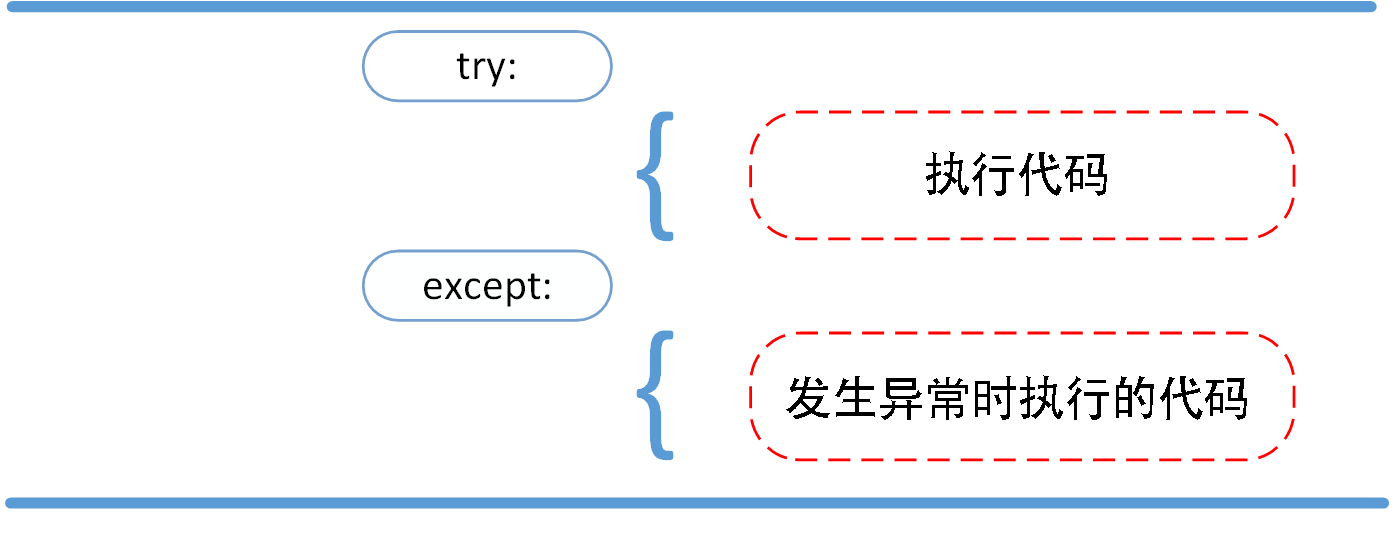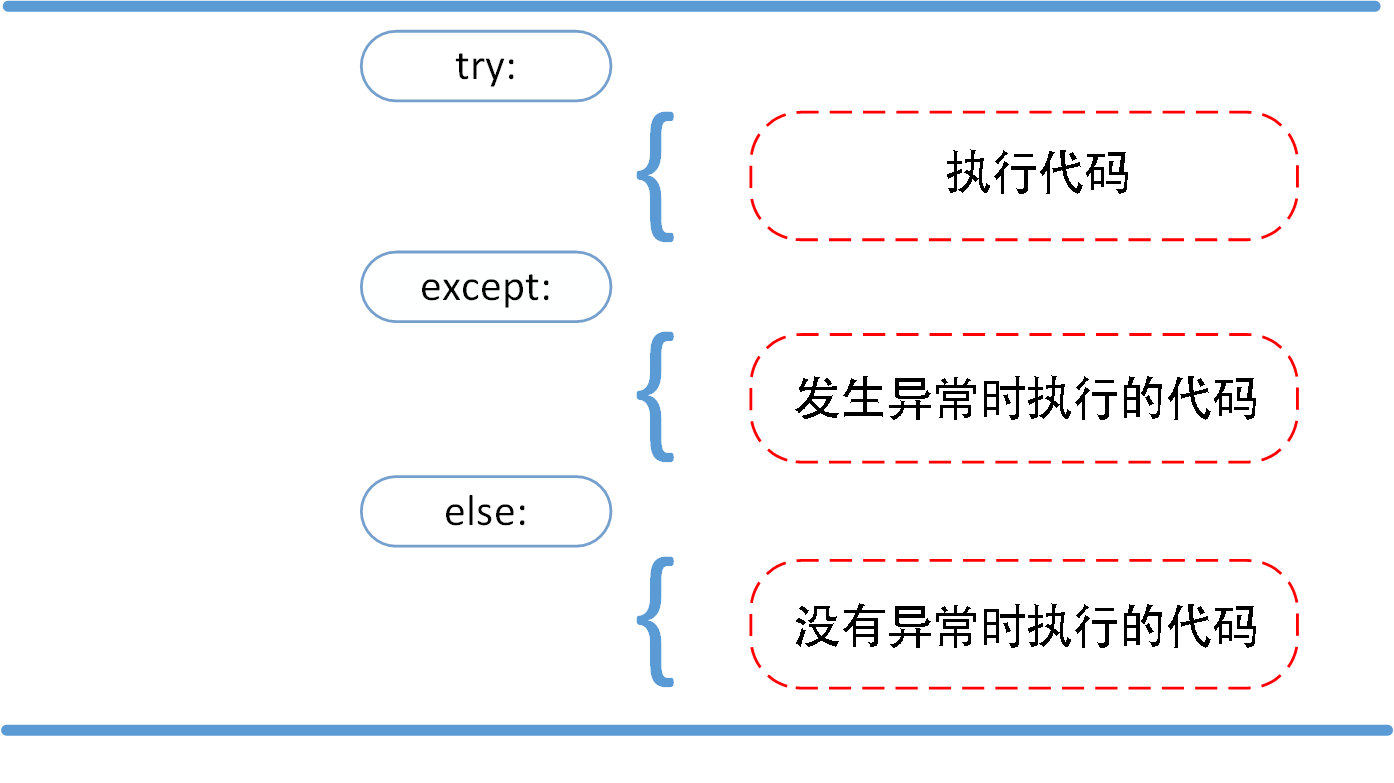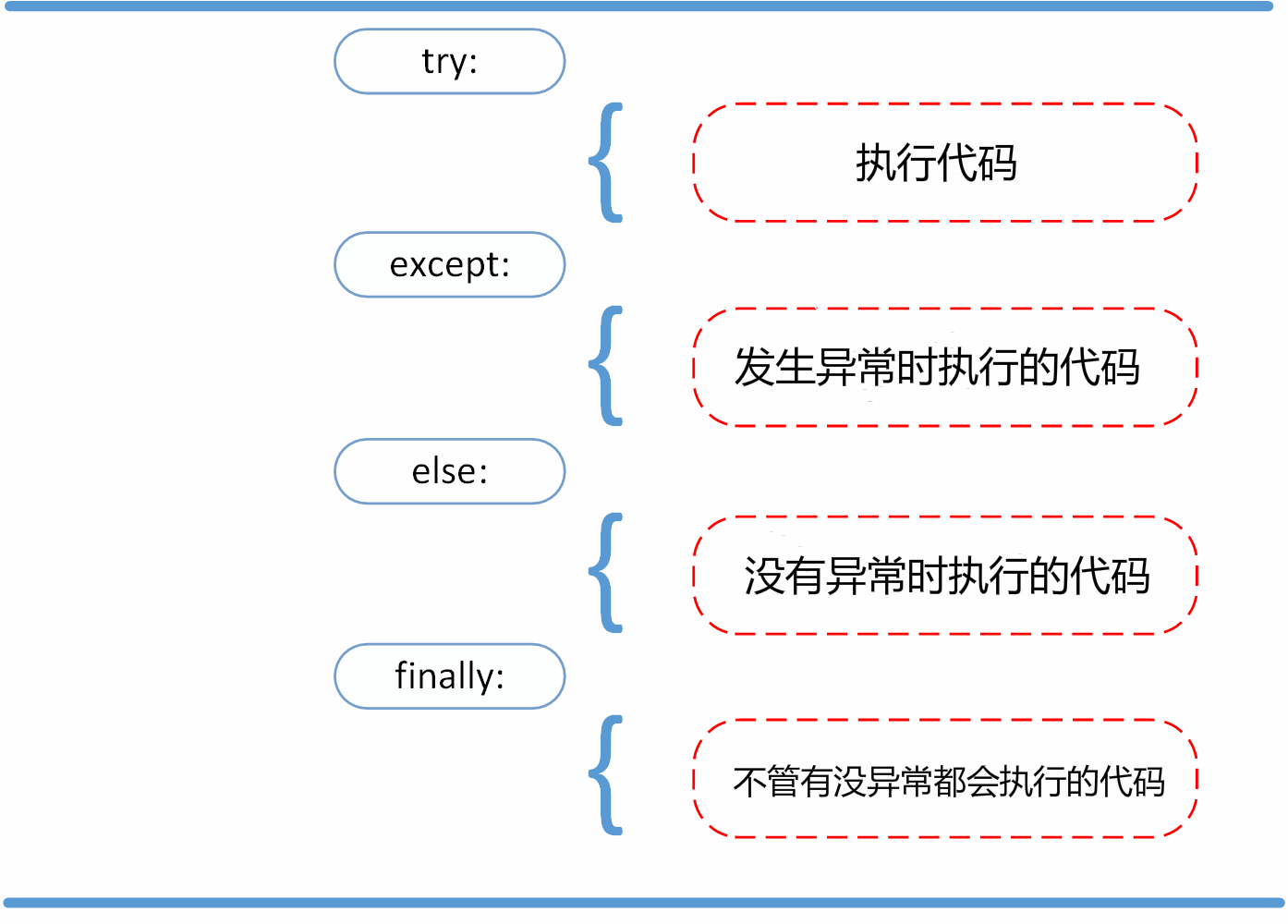Python3 错误和异常
作为 Python 初学者,在刚学习 Python 编程时,经常会看到一些报错信息,在前面我们没有提及,这章节我们会专门介绍。
Python 有两种错误很容易辨认:语法错误和异常。
Python assert(断言)用于判断一个表达式,在表达式条件为 false 的时候触发异常。

语法错误
Python 的语法错误或者称之为解析错,是初学者经常碰到的,如下实例
>>> while True print('Hello world') File "<stdin>", line 1, in ? while True print('Hello world') ^ SyntaxError: invalid syntax
这个例子中,函数 print() 被检查到有错误,是它前面缺少了一个冒号 : 。
语法分析器指出了出错的一行,并且在最先找到的错误的位置标记了一个小小的箭头。
异常
即便 Python 程序的语法是正确的,在运行它的时候,也有可能发生错误。运行期检测到的错误被称为异常。
大多数的异常都不会被程序处理,都以错误信息的形式展现在这里:
实例
>>> 10 * (1/0) # 0 不能作为除数,触发异常 Traceback (most recent call last): File "<stdin>", line 1, in ? ZeroDivisionError: division by zero >>> 4 + spam*3 # spam 未定义,触发异常 Traceback (most recent call last): File "<stdin>", line 1, in ? NameError: name 'spam' is not defined >>> '2' + 2 # int 不能与 str 相加,触发异常 Traceback (most recent call last): File "<stdin>", line 1, in <module> TypeError: can only concatenate str (not "int") to str
异常以不同的类型出现,这些类型都作为信息的一部分打印出来: 例子中的类型有 ZeroDivisionError,NameError 和 TypeError。
错误信息的前面部分显示了异常发生的上下文,并以调用栈的形式显示具体信息。
异常处理
try/except
异常捕捉可以使用 try/except 语句。

以下例子中,让用户输入一个合法的整数,但是允许用户中断这个程序(使用 Control-C 或者操作系统提供的方法)。用户中断的信息会引发一个 KeyboardInterrupt 异常。
while True: try: x = int(input("请输入一个数字: ")) break except ValueError: print("您输入的不是数字,请再次尝试输入!")
try 语句按照如下方式工作;
-
首先,执行 try 子句(在关键字 try 和关键字 except 之间的语句)。
-
如果没有异常发生,忽略 except 子句,try 子句执行后结束。
-
如果在执行 try 子句的过程中发生了异常,那么 try 子句余下的部分将被忽略。如果异常的类型和 except 之后的名称相符,那么对应的 except 子句将被执行。
-
如果一个异常没有与任何的 except 匹配,那么这个异常将会传递给上层的 try 中。
一个 try 语句可能包含多个except子句,分别来处理不同的特定的异常。最多只有一个分支会被执行。
处理程序将只针对对应的 try 子句中的异常进行处理,而不是其他的 try 的处理程序中的异常。
一个except子句可以同时处理多个异常,这些异常将被放在一个括号里成为一个元组,例如:
pass
最后一个except子句可以忽略异常的名称,它将被当作通配符使用。你可以使用这种方法打印一个错误信息,然后再次把异常抛出。
import sys try: f = open('myfile.txt') s = f.readline() i = int(s.strip()) except OSError as err: print("OS error: {0}".format(err)) except ValueError: print("Could not convert data to an integer.") except: print("Unexpected error:", sys.exc_info()[0]) raise
try/except...else
try/except 语句还有一个可选的 else 子句,如果使用这个子句,那么必须放在所有的 except 子句之后。
else 子句将在 try 子句没有发生任何异常的时候执行。

以下实例在 try 语句中判断文件是否可以打开,如果打开文件时正常的没有发生异常则执行 else 部分的语句,读取文件内容:
for arg in sys.argv[1:]: try: f = open(arg, 'r') except IOError: print('cannot open', arg) else: print(arg, 'has', len(f.readlines()), 'lines') f.close()
使用 else 子句比把所有的语句都放在 try 子句里面要好,这样可以避免一些意想不到,而 except 又无法捕获的异常。
异常处理并不仅仅处理那些直接发生在 try 子句中的异常,而且还能处理子句中调用的函数(甚至间接调用的函数)里抛出的异常。例如:
>>> def this_fails(): x = 1/0 >>> try: this_fails() except ZeroDivisionError as err: print('Handling run-time error:', err) Handling run-time error: int division or modulo by zero
try-finally 语句
try-finally 语句无论是否发生异常都将执行最后的代码。

以下实例中 finally 语句无论异常是否发生都会执行:
实例
try: runoob() except AssertionError as error: print(error) else: try: with open('file.log') as file: read_data = file.read() except FileNotFoundError as fnf_error: print(fnf_error) finally: print('这句话,无论异常是否发生都会执行。')
抛出异常
Python 使用 raise 语句抛出一个指定的异常。
raise语法格式如下:
raise [Exception [, args [, traceback]]]

以下实例如果 x 大于 5 就触发异常:
x = 10 if x > 5: raise Exception('x 不能大于 5。x 的值为: {}'.format(x)) 执行以上代码会触发异常: Traceback (most recent call last): File "test.py", line 3, in <module> raise Exception('x 不能大于 5。x 的值为: {}'.format(x)) Exception: x 不能大于 5。x 的值为: 10
raise 唯一的一个参数指定了要被抛出的异常。它必须是一个异常的实例或者是异常的类(也就是 Exception 的子类)。
如果你只想知道这是否抛出了一个异常,并不想去处理它,那么一个简单的 raise 语句就可以再次把它抛出。
>>> try: raise NameError('HiThere') except NameError: print('An exception flew by!') raise An exception flew by! Traceback (most recent call last): File "<stdin>", line 2, in ? NameError: HiThere
用户自定义异常
你可以通过创建一个新的异常类来拥有自己的异常。异常类继承自 Exception 类,可以直接继承,或者间接继承,例如:
>>> class MyError(Exception): def __init__(self, value): self.value = value def __str__(self): return repr(self.value) >>> try: raise MyError(2*2) except MyError as e: print('My exception occurred, value:', e.value) My exception occurred, value: 4 >>> raise MyError('oops!') Traceback (most recent call last): File "<stdin>", line 1, in ? __main__.MyError: 'oops!'
在这个例子中,类 Exception 默认的 __init__() 被覆盖。
<p异常的类可以像其他的类一样做任何事情,但是通常都会比较简单,只提供一些错误相关的属性,并且允许处理异常的代码方便的获取这些信息。< p="">
当创建一个模块有可能抛出多种不同的异常时,一种通常的做法是为这个包建立一个基础异常类,然后基于这个基础类为不同的错误情况创建不同的子类:
class Error(Exception): """Base class for exceptions in this module.""" pass class InputError(Error): """Exception raised for errors in the input. Attributes: expression -- input expression in which the error occurred message -- explanation of the error """ def __init__(self, expression, message): self.expression = expression self.message = message class TransitionError(Error): """Raised when an operation attempts a state transition that's not allowed. Attributes: previous -- state at beginning of transition next -- attempted new state message -- explanation of why the specific transition is not allowed """ def __init__(self, previous, next, message): self.previous = previous self.next = next self.message = message
大多数的异常的名字都以"Error"结尾,就跟标准的异常命名一样。
定义清理行为
try 语句还有另外一个可选的子句,它定义了无论在任何情况下都会执行的清理行为。 例如:
>>> try: ... raise KeyboardInterrupt ... finally: ... print('Goodbye, world!') ... Goodbye, world! Traceback (most recent call last): File "<stdin>", line 2, in <module> KeyboardInterrupt
以上例子不管 try 子句里面有没有发生异常,finally 子句都会执行。
如果一个异常在 try 子句里(或者在 except 和 else 子句里)被抛出,而又没有任何的 except 把它截住,那么这个异常会在 finally 子句执行后被抛出。
下面是一个更加复杂的例子(在同一个 try 语句里包含 except 和 finally 子句):
>>> def divide(x, y): try: result = x / y except ZeroDivisionError: print("division by zero!") else: print("result is", result) finally: print("executing finally clause") >>> divide(2, 1) result is 2.0 executing finally clause >>> divide(2, 0) division by zero! executing finally clause >>> divide("2", "1") executing finally clause Traceback (most recent call last): File "<stdin>", line 1, in ? File "<stdin>", line 3, in divide TypeError: unsupported operand type(s) for /: 'str' and 'str'
预定义的清理行为
一些对象定义了标准的清理行为,无论系统是否成功的使用了它,一旦不需要它了,那么这个标准的清理行为就会执行。
这面这个例子展示了尝试打开一个文件,然后把内容打印到屏幕上:
for line in open("myfile.txt"): print(line, end="")
以上这段代码的问题是,当执行完毕后,文件会保持打开状态,并没有被关闭。
关键词 with 语句就可以保证诸如文件之类的对象在使用完之后一定会正确的执行他的清理方法:
with open("myfile.txt") as f: for line in f: print(line, end="")
以上这段代码执行完毕后,就算在处理过程中出问题了,文件 f 总是会关闭。
Python3 assert(断言)
Python assert(断言)用于判断一个表达式,在表达式条件为 false 的时候触发异常。
断言可以在条件不满足程序运行的情况下直接返回错误,而不必等待程序运行后出现崩溃的情况,例如我们的代码只能在 Linux 系统下运行,可以先判断当前系统是否符合条件。

语法格式如下: assert expression 等价于: if not expression: raise AssertionError assert 后面也可以紧跟参数: assert expression [, arguments] 等价于: if not expression: raise AssertionError(arguments) 以下为 assert 使用实例: >>> assert True # 条件为 true 正常执行 >>> assert False # 条件为 false 触发异常 Traceback (most recent call last): File "<stdin>", line 1, in <module> AssertionError >>> assert 1==1 # 条件为 true 正常执行 >>> assert 1==2 # 条件为 false 触发异常 Traceback (most recent call last): File "<stdin>", line 1, in <module> AssertionError >>> assert 1==2, '1 不等于 2' Traceback (most recent call last): File "<stdin>", line 1, in <module> AssertionError: 1 不等于 2 >>>
以下实例判断当前系统是否为 Linux,如果不满足条件则直接触发异常,不必执行接下来的代码:
实例
assert ('linux' in sys.platform), "该代码只能在 Linux 下执行"
# 接下来要执行的代码
Python Traceback详解
刚接触Python的时候,简单的异常处理已经可以帮助我们解决大多数问题,但是随着逐渐地深入,我们会发现有很多情况下简单的异常处理已经无法解决问题了,如下代码,单纯的打印异常所能提供的信息会非常有限。
def func1():
raise Exception("--func1 exception--")
def main():
try:
func1()
except Exception as e:
print e
if __name__ == '__main__':
main()
执行后输出如下:
--func1 exception--
通过示例,我们发现普通的打印异常只有很少量的信息(通常是异常的value值),这种情况下我们很难定位在哪块代码出的问题,以及如何出现这种异常。那么到底要如何打印更加详细的信息呢?下面我们就来一一介绍。
sys.exc_info和traceback object
Python程序的traceback信息均来源于一个叫做traceback object的对象,而这个traceback object通常是通过函数sys.exc_info()来获取的,先来看一个例子:
import sys
def func1():
raise NameError("--func1 exception--")
def main():
try:
func1()
except Exception as e:
exc_type, exc_value, exc_traceback_obj = sys.exc_info()
print "exc_type: %s" % exc_type
print "exc_value: %s" % exc_value
print "exc_traceback_obj: %s" % exc_traceback_obj
if __name__ == '__main__':
main()
执行后输出如下:
exc_type: <type 'exceptions.NameError'>
exc_value: --func1 exception--
exc_traceback_obj: <traceback object at 0x7faddf5d93b0>
通过以上示例我们可以看出,sys.exc_info()获取了当前处理的exception的相关信息,并返回一个元组,元组的第一个数据是异常的类型(示例是NameError类型),第二个返回值是异常的value值,第三个就是我们要的traceback object.
有了traceback object我们就可以通过traceback module来打印和格式化traceback的相关信息,下面我们就来看下traceback module的相关函数。
traceback module
Python的traceback module提供一整套接口用于提取,格式化和打印Python程序的stack traces信息,下面我们通过例子来详细了解下这些接口:
print_tb
import sys
import traceback
def func1():
raise NameError("--func1 exception--")
def main():
try:
func1()
except Exception as e:
exc_type, exc_value, exc_traceback_obj = sys.exc_info()
traceback.print_tb(exc_traceback_obj)
if __name__ == '__main__':
main()
输出:
File "<ipython-input-23-52bdf2c9489c>", line 11, in main
func1()
File "<ipython-input-23-52bdf2c9489c>", line 6, in func1
raise NameError("--func1 exception--")
这里我们可以发现打印的异常信息更加详细了,下面我们了解下print_tb的详细信息:
traceback.print_tb(tb[, limit[, file]])
- tb: 这个就是traceback object, 是我们通过sys.exc_info获取到的
- limit: 这个是限制stack trace层级的,如果不设或者为None,就会打印所有层级的stack trace
- file: 这个是设置打印的输出流的,可以为文件,也可以是stdout之类的file-like object。如果不设或为None,则输出到sys.stderr。
print_exception
import sys
import traceback
def func1():
raise NameError("--func1 exception--")
def func2():
func1()
def main():
try:
func2()
except Exception as e:
exc_type, exc_value, exc_traceback_obj = sys.exc_info()
traceback.print_exception(exc_type, exc_value, exc_traceback_obj, limit=2, file=sys.stdout)
if __name__ == '__main__':
main()
输出:
Traceback (most recent call last):
File "<ipython-input-24-a68061acf52f>", line 13, in main
func2()
File "<ipython-input-24-a68061acf52f>", line 9, in func2
func1()
NameError: --func1 exception--
看下定义:
traceback.print_exception(etype, value, tb[, limit[, file]])
- 跟print_tb相比多了两个参数etype和value,分别是exception type和exception value,加上tb(traceback object),正好是sys.exc_info()返回的三个值
- 另外,与print_tb相比,打印信息多了开头的"Traceback (most...)"信息以及最后一行的异常类型和value信息
- 还有一个不同是当异常为SyntaxError时,会有"^"来指示语法错误的位置
print_exc
print_exc是简化版的print_exception, 由于exception type, value和traceback object都可以通过sys.exc_info()获取,因此print_exc()就自动执行exc_info()来帮助获取这三个参数了,也因此这个函数是我们的程序中最常用的,因为它足够简单
import sys
import traceback
def func1():
raise NameError("--func1 exception--")
def func2():
func1()
def main():
try:
func2()
except Exception as e:
traceback.print_exc(limit=1, file=sys.stdout)
if __name__ == '__main__':
main()
输出(由于limit=1,因此只有一个层级被打印出来):
Traceback (most recent call last):
File "<ipython-input-25-a1f5c73b97c4>", line 13, in main
func2()
NameError: --func1 exception--
定义如下:
traceback.print_exc([limit[, file]])
- 只有两个参数,够简单
format_exc
import logging
import sys
import traceback
logger = logging.getLogger("traceback_test")
def func1():
raise NameError("--func1 exception--")
def func2():
func1()
def main():
try:
func2()
except Exception as e:
logger.error(traceback.format_exc(limit=1, file=sys.stdout))
if __name__ == '__main__':
main()
从这个例子可以看出有时候我们想得到的是一个字符串,比如我们想通过logger将异常记录在log里,这个时候就需要format_exc了,这个也是最常用的一个函数,它跟print_exc用法相同,只是不直接打印而是返回了字符串。
traceback module中还有一些其它的函数,但因为并不常用,就不在展开来讲,感兴趣的同学可以看下参考链接中的文档。
获取线程中的异常信息
通常情况下我们无法将多线程中的异常带回主线程,所以也就无法打印线程中的异常,而通过上边学到这些知识,我们可以对线程做如下修改,从而实现捕获线程异常的目的。
import threading
import traceback
def my_func():
raise BaseException("thread exception")
class ExceptionThread(threading.Thread):
def __init__(self, group=None, target=None, name=None, args=(), kwargs=None, verbose=None):
"""
Redirect exceptions of thread to an exception handler.
"""
threading.Thread.__init__(self, group, target, name, args, kwargs, verbose)
if kwargs is None:
kwargs = {}
self._target = target
self._args = args
self._kwargs = kwargs
self._exc = None
def run(self):
try:
if self._target:
self._target()
except BaseException as e:
import sys
self._exc = sys.exc_info()
finally:
#Avoid a refcycle if the thread is running a function with
#an argument that has a member that points to the thread.
del self._target, self._args, self._kwargs
def join(self):
threading.Thread.join(self)
if self._exc:
msg = "Thread '%s' threw an exception: %s" % (self.getName(), self._exc[1])
new_exc = Exception(msg)
raise new_exc.__class__, new_exc, self._exc[2]
t = ExceptionThread(target=my_func, name='my_thread')
t.start()
try:
t.join()
except:
traceback.print_exc()
输出如下:
Traceback (most recent call last):
File "/data/code/testcode/thread_exc.py", line 43, in <module>
t.join()
File "/data/code/testcode/thread_exc.py", line 23, in run
self._target()
File "/data/code/testcode/thread_exc.py", line 5, in my_func
raise BaseException("thread exception")
Exception: Thread 'my_thread' threw an exception: thread exception
这样我们就得到了线程中的异常信息。